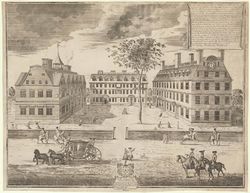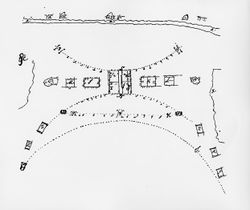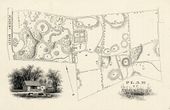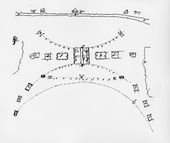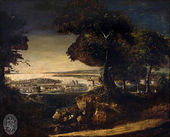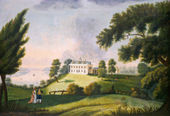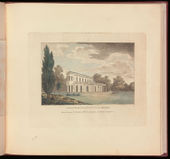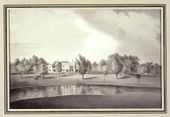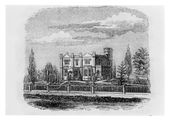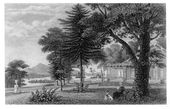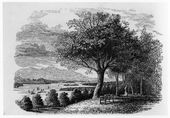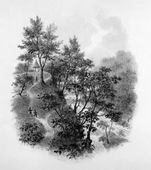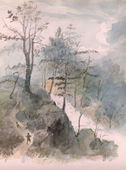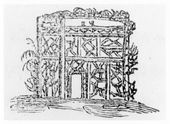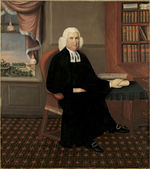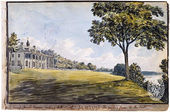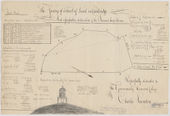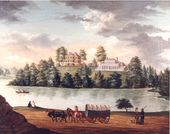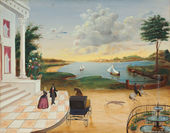Difference between revisions of "Prospect"
V-Federici (talk | contribs) m |
V-Federici (talk | contribs) m (→Inscribed) |
||
| Line 320: | Line 320: | ||
File:0399.jpg|Anonymous, “Design for a [[Rustic_style|rustic]] '''prospect''' tower,” in [[A. J. Downing]], ''A Treatise on the Theory and Practice of Landscape Gardening'', 4th ed. (1849), 460, fig. 88. | File:0399.jpg|Anonymous, “Design for a [[Rustic_style|rustic]] '''prospect''' tower,” in [[A. J. Downing]], ''A Treatise on the Theory and Practice of Landscape Gardening'', 4th ed. (1849), 460, fig. 88. | ||
| + | |||
| + | File:2297.jpg|Matthew Vassar, ''Plan of Springside'', 1851. "'''Prospect''' Hill (33). . . rises high above the others, and affords extensive [[view]]. . ." | ||
</gallery> | </gallery> | ||
Revision as of 13:36, April 12, 2021
See also: View
History
A prospect, like other keywords such as vista, view, and eminence, was a significant aspect of the visual organization and perception of the American landscape. As Samuel Johnson’s 1755 definitions indicate, the term was used to describe an object in view, the view itself, or the place that afforded a view. The term also denoted the pictorial representation of a landscape, such as William Burgis’s [A prospect of the colleges in Cambridge in New England] in New England (1743) [Fig. 1] or “Prospect of Bethabara” in Salem, North Carolina (c. 1759) [Fig. 2].
Prospects were much admired, even by the earliest recorders of American gardens. Travelers, such as William Byrd II in 1733, praised prospects in the natural scenery, and gardeners capitalized whenever possible upon views and vistas in their estate grounds. The prospect encompassed, as J.-P. Brissot de Warville observed in 1788, “the perpetual contrast of savage nature and the efforts of art.” As early as 1685, William Penn requested a prospect to be created through his woods at Pennsbury Manor, near Philadelphia. Thomas Hancock in 1736 also lauded the view from his gardens on Beacon Hill in Boston, saying that: “the Kingdom of England don’t afford so Fine a Prospect as I have both of Land and Water.”
The most significant aspect of creating a prospect, as J. Mortimer’s 1708 poem suggests, was the siting of one’s dwelling or garden on elevated ground, such as an eminence or the bank of a river. Gardeners then took advantage of the natural setting by planting trees, clumps, shrubberies and hedges to open up and frame distant views. The unknown designer of grounds for the Elias Hasket Derby House (c. 1800) in Salem, Massachusetts, instructed the executers of his plan to adapt it, if possible, to the existing views by substituting a ha-ha in the place of a thicket of trees, if a “prospect that is agreeable. . . [could be seen] from the House.” The sunken fence would allow the prospect to continue beyond the borders of the property.
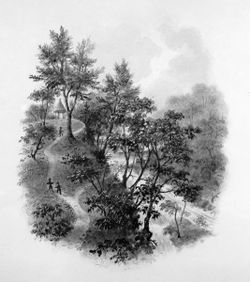
Prospects were enhanced at prominent locations by seats, pavilions, and garden houses to be used for the enjoyment and repose of those walking through the garden [Fig. 3]. As A. J. Downing noted in 1849, prospect towers were particularly suitable “where the view is comparatively limited from the grounds.” Prospects were also created within the garden by placing an object, building, or some other focal point, at a distance from the house or at intervals in the garden. James Gibbs's popular architectural pattern book (1728) provided the example of a temple placed “upon the upper ground of an Amphitheatre,” where trees “render the Prospect of the Building very agreeable.” American examples were rarely implemented on such a grand scale, yet the impetus to create a pleasing object of view was the same. In 1743, Eliza Lucas Pinckney wrote that fish ponds created a “fine prospect of water from the house” at William Middleton’s plantation, Crowfield, near Charleston, South Carolina. Similarly, in 1762 Hannah Callender Sansom described the multiple prospects from the doorway of Judge William Peters's Belmont Mansion, near Philadelphia; in one direction she looked across gravel walks to the city, and in the other direction along an avenue terminated by an obelisk.
While the style of the garden architecture and the composition of the view itself varied, the principle of a prospect remained the same—the extension of the garden through visual sight lines into the surrounding landscape. These views were not only valued as aesthetically pleasing, but were also equated with ownership and control of one’s domain. Recorders of the landscape repeatedly praised “commanding prospects” and “extensive views.” Bernard M’Mahon noted in 1806 the “air of grandeur. . . of a full prospect from and to the mansion.” The “embracing of a view” signified not only the owners’ knowledge and taste in creating the landscape garden through which the prospects were viewed, but also their enviable situation and extensive properties.[1]
—Elizabeth Kryder-Reid
Texts
Usage
- Penn, William, November 7, 1685, describing Pennsbury Manor, country estate of William Penn, near Philadelphia, PA (quoted in Thomforde 1986: 46)[2]
- “Clear a way ye wood up ye river to open a prospect upwards as well as downwards.”
- Byrd, William, II, 1733, describing travels in West Virginia (1928: 290)[3]
- “It must have been a great misfortune to them to be obliged to abandon so beautiful a dwelling, where the air is wholesome, and the soil equal in fertility to any in the world. The river is about eighty yards wide, always confined with in its lofty banks, and rolling down its waters, as sweet as milk, and as clear as crystal. There runs a charming level, of more than a mile square, that will bring forth like the lands of Egypt, without being overflowed once a year. There is scarce a shrub in view to intercept your prospect, but grass as high as a man on horseback. Towards the woods there is a gentle ascent, till your sight is intercepted by an eminence, that overlooks the whole landscape.”
- Hancock, Thomas, December 20, 1736, describing the garden of Thomas Hancock on Beacon Hill, Boston, MA (quoted in Hedrick 1988: 49)[4]
- “My Gardens all Lye on the South Side of a hill, with the most Beautifull Assent to the Top & it is Allowed on all hands the Kingdom of England don’t afford So Fine a Prospect as I have both of Land and water.”
- Pinckney, Eliza Lucas, May 1743, in a letter to Miss Bartlett, describing Crowfield, plantation of William Middleton, vicinity of Charleston, SC (1972: 61)[5]
- “. . . come to the bottom of this charming spott where is a large fish pond with a mount rising out of the middle—the top of which is level with the dwelling house and upon it is a roman temple. On each side of this are other large fish ponds properly disposed which form a fine prospect of water from the house.”
- Anonymous, July 9, 1748, describing a property for sale near Charleston, SC (South Carolina Gazette)
- “. . . a beautiful Pond, supplied with Fish, at the End of the Garden, which is well laid out, and furnished with a variety of Trees as Orange, Laurel, &c. from thence are several delightful Prospects into Cooper and Ashley-Rivers, by Visto’s.”
- Sansom, Hannah Callender, June 30, 1762, diary entry describing Belmont, estate of William Peters, near Philadelphia, PA (quoted in Callender 2010: 183)[6]
- “. . . a broad walk of english Cherre trys leads down to the river, the doors of the hous opening opposite admitt a prospect [of] the length of the garden thro’ a broad gravel walk, to a large hansome summer house in a grean. . .”
- Quincy, Josiah, May 3, 1773, describing the country seat of John Dickinsen, near Philadelphia, PA (Massachusetts Historical Society Proceedings 49: 473)[7]
- “. . . his gardens, green-house, bathing-house, grotto, study, fish-pond, fields, meadows, vista, through which is a distant prospect of Delaware River.”
- Adams, John, February 17, 1777, describing Chatsworth, estate of William Lux, Baltimore, MD (quoted in Sarudy 1989: 125)[8]
- “The seat is named Chatsworth, and an elegant one it is—the large garden enclosed in lime and before the yard two fine rows of large cherry trees which lead out to the public road. There is a fine prospect about it. Mr. Lux lives like a prince.”
- Hazard, Ebenezer, June 30, 1777, describing Stafford County, VA (quoted in Shelley 1954: 417–18)[9]
- “A little above Falmouth are Mr. Hunter’s Works. . . He is now erecting a Mill for slitting & plating Iron. . .
- “The Steel Manufactory is situated on a high Hill which commands a beautiful & extensive Prospect.”
- Enys, Lt. John, December 9, 1787, describing Hancock House, seat of his Excellency John Hancock, Boston, MA (Cometti 1976: 205)[10]
- “. . . there are a number of houses situated on Beacon hill which stand high and command eligant prospects particularly at high water. That of Governor Hancock stands the most conspicuous just at the top of the common with a full view of the Mall before it besides its distant views of the harbour and adjacent country.” [Fig. 4]
- Anburey, Thomas, September 2, 1781, describing the Moravian community in Bethlehem, PA (1789; repr., 1969: 2:513)[11]
- “The house of the single men is upon the same principle as that of the women; upon the roof of which is a Belvidere, from whence you have not only a most delightful prospect, but a distinct view of the whole settlement.”
- Hawks, John, July 12, 1783, describing the Governor’s House, New Bern, NC (Colonial Williamsburg Foundation)
- “It was agreed for the advantage of a prospect down the river, that the South front should be thrown more to the Eastward which leaves the Gardens not quite so regular as appears in the sketch.”
- Shippen, Thomas Lee, December 30, 1783, describing Westover, seat of William Byrd III, on the James River, VA (1952: n.p.)[12]
- “Imagine then a room of 20 feet square. . . and commanding a view of a prettily falling grass plat. . . about 300 by 100 yards in extent an extensive prospect of James River and of all the Country and some Gentlemen’s seats on the other side.” [Fig. 5]
- Cutler, Manasseh, June 30, 1787, describing the estate of Charles Wyllys Elliott, near Hartford, CT (1987: 1:211)[13]
- “I also called on my classmate, Colonel Hezekiah Wyllys. He lives with his father, Colonel Wyllys, the Secretary of the State, in an elegant seat just outside the city, situated on a high eminence which overlooks the city and commands a most enchanting prospect of the river, meandering through rich meadows and fertile fields, for ten or fifteen miles. The landscape from this seat far exceeds any I have ever seen in any part of the country.”
- Brissot de Warville, J.-P., 1788, describing Mount Vernon, plantation of George Washington, Fairfax County, VA (1792: 428)[14]
- “This house overlooks the Potowmack, enjoys an extensive prospect, has a vast and elevated portico on the front next the river, and a convenient distribution of the apartments within.”
- Enys, Lt. John, January 26, 1788, describing Belvedere, estate of Gov. John Eager Howard, Baltimore, MD (Cometti 1976: 235)[10]
- “. . . there are some very Charming prospects from some of the Hills, among the rest from the Seat of Colol. Howard which is situated on an eminence but is well coverd by trees from all the cold winds, has a charming View of a Water fall at a Mill, a long Rapid below it, a full View of the town of Baltimore and the Point with the shiping in the harbour, the Bason and all the Small craft, with a very distant prospect down the river towards the Chasapeak Bay. The whole terminated by the surrounding Hills forms a fine Picture.”
- G., L., June 15, 1788, describing The Woodlands, seat of William Hamilton, near Philadelphia, PA (quoted in Madsen 1988: B2, 19)[15]
- “The prospect from every room is enchanting, as you enter the hall you have a view of a remarkably fine lawn, beyond that, the bridge over which people are constantly passing, the rocky ground opposite to Gray’s, four or five windings of the Schuylkill, the intermediate country & the Delaware terminated by the blue mist of the Jersey shore—on one side you see distinctly the City & the surrounding country, on the opposite end, another view of the Schuylkill & the greenhouse—at the back the eye is refreshed with the sight of the most beautiful trees. . .
- “[[[Walk]]s were] planted on each side with the most beautiful & curious flowers & shrubs. They are in some parts enclosed with the Lombardy poplar except here & there openings are left to give you a view of some fine trees or beautiful prospect beyond, & in others, shaded by arbours of the wild grape, or clumps of large trees under which are placed seats where you may rest yourself & enjoy the cool air.”
- Brissot de Warville, J.-P., August 9, 1788, describing the journey from Boston, MA, to New York, NY (1792: 125)[14]
- “The traveller is well recompensed for the fatigue of this route, by the variety of romantic situations, by the beauty of the prospects which it offers at each step, by the perpetual contrast of savage nature and the efforts of art.”
- Constantia [Judith Sargent Murray], June 24, 1790, “Description of Gray’s Gardens, Pennsylvania” (Massachusetts Magazine 3: 415)[16]
- “Suddenly, however, an open plain is outspread before us, and we are presented with a pleasing horizon—but as suddenly, thick trees again intervene, until at the extremity of the walks, a mill and a beautiful natural cascade terminates the prospect.”
- Bentley, William, September 22, 1790, describing an estate in Haverville, MA (1962: 1:198)[17]
- “It has about 30 acres of land, an ancient row of Elms, & Buttons, & most engaging Prospect of the River and adjacent country.”
- Smith, William Loughton, April 23, 1791, describing Mount Vernon, plantation of George Washington, Fairfax County, VA (1917: 63)[18]
- “I hardly remember to have been so struck with a prospect. . . the view extends up and down the river a considerable distance, the river is about two miles wide, and the opposite shore is beautiful. . . embracing the magnificence of the river with the vessels sailing about; the verdant fields, woods, and parks.”
- L’Enfant, Pierre-Charles, 1791 and 1792, describing plans for Washington, DC (quoted in Caemmerer 1950: 151 and 163)[19]
- “[June 22, 1791]. . . I next made the distribution regular with streets at right angle north-south and east west but afterwards I opened others on various directions as avenues to and from every principal places, wishing by this not merely to contrast with the general regularity nor to afford a greater variety of pleasant seats and prospect as will be obtained from the advantageous ground over the which the avenues are mostly directed but principally to connect each part of the city with more efficacy. . .
- “[January 4, 1792 ] ‘I. The positions for the different Grand Edifices, and for the several Grand Squares or Areas of different shapes as they are laid down, were first determined on the most advantageous ground, commanding the most extensive prospects, and the better susceptible of such improvements as the various intents of the several objects may require.’”
- La Rochefoucauld Liancourt, François Alexandre-Frédéric, duc de, 1795–97, describing Norristown, PA (1800: 1:7)[20]
- “The contrast between the rocks, which form the banks of this river Schuykill, and the numerous meadows and adjacent corn fields, gives this prospect a mixture of romantic wildness, and cultivated beauty, which is really delightful.”
- Twining, Thomas, May 7, 1795, describing Belvedere, estate of Gov. John Eager Howard, Baltimore, MD (1894: 115–16)[21]
- “Situated upon the verge of the descent upon which Baltimore stands, its grounds formed a beautiful slant towards the Chesapeak. . . The spot, thus indebted to nature and judiciously embellished, was as enchanting within its own proper limits as in the fine view which extended far beyond them. The foreground presented luxurious shrubberies and sloping lawns: the distance, the line of the Patapsco, and the country bordering on Chesapeak Bay. Both the perfections of the landscape, its near and distant scenery, were united in the view from the bow-window of the noble room in which breakfast was prepared, with the desire, I believe, of gratifying me with this exquisite prospect.” [Fig. 6]
- Dwight, Timothy, 1796, describing New England (1821: 1:18)[22]
- “A succession of New-England villages, composed of neat houses, surrounding neat schoolhouses and churches, adorned with gardens, meadows and orchards, and exhibiting the universally easy circumstances of the inhabitants, is, at least in my own opinon, one of the most delightful prospects, which this world can afford.”
- Weld, Isaac, 1799, describing the White House, Washington, DC (1799: 47)[23]
- “The house for the residence of the president stands north-west of the capitol, at the distance of about one mile and a half. It is situated upon a rising ground not far from the Patowmac, and commands a most beautiful prospect of the river, and of the rich country beyond it.”
- Anonymous, June 6, 1800, describing in the Columbian Museum and Savannah Advertiser a rental property in Savannah, GA (Colonial Williamsburg Foundation)
- “TO LET, THAT pleasantly situated HOUSE on the corner of St. Julian and Price Streets, in which are many conveniencies for a family. . . piazza and a good prospect.”
- Anonymous, c. 1800, describing a design for Elias Hasket Derby Farm, Peabody, MA (Peabody Essex Institute, Phillips Library, Derby Papers)
- “If there is any Prospect that is agreeable can be seen from the House make a Ha Ha instead of a Thicket.”
- Anonymous, March 2, 1802, describing a property for sale in King George County, VA (Virginia Herald)
- “It lies on the Rappahannock river, about three miles from the town of Port Royal, and twenty four from Fredericksburg. . .
- “On an eminence which commands a beautiful distant prospect, and an entire view of the low ground belonging to this Tract, I have lately erected a two story dwelling house, and some necessary out houses.”
- Jefferson, Thomas, 1804, describing Monticello, plantation of Thomas Jefferson, Charlottesville, VA (Massachusetts Historical Society, Jefferson Papers)
- “. . . the ground between the upper & lower roundabouts to be laid out in lawns & clumps of trees, the lawns opening so as to give advantageous catches of prospect to the upper roundabout.
- “Vistas from the lower roundabout to good portions of prospect walks in this style, winding up the mountain.”
- Foster, Sir Augustus John, c. 1807, describing Montpelier, plantation of James Madison, Montpelier Station, VA (1954: 142)[24]
- “The ladies, however, whom I have known in Virginia, like those of Italy generally speaking, scarcely even venture out of their houses to walk or to enjoy beautiful scenery. A high situation from whence they can have an extensive prospect is their delight and in fact the heat is too great in these latitudes to allow of such English tastes to exist in the same degree at least as in the mother country. A pleasure ground, too, to be kept in order, would in fact be very expensive, and all hands are absolutely wanted for the plantation.”
- Ripley, Samuel, 1815, describing the Vale, estate of Theodore Lyman, Waltham, MA (1815: 272)[25]
- “The situation of the house is not elevated; and no part of the highly cultivated grounds affords any prospect far beyond their limits. However desirable and necessary this property may be with respect to some situations, the want of it is not materially felt at Mr. Lyman’s. For when there, you behold so much to admire and approve, so much taste and elegance, so great convenience and comfort, that you desire no other prospects, than those before and around you;—you are satisfied with contemplating the improvements of art and refinement upon nature, how they can render her more charming, more instructive, and bring into more full display the wisdom and goodness of nature’s God.” [Fig. 7]
- Lambert, John, 1816, describing Columbia, SC (1816: 2:185)[26]
- “The buildings are erected about three quarters of a mile from the Congaree, on a ridge of high land, near 300 feet above the level of the river, from which a delightful prospect is presented.”
- Anonymous, July 1828, describing the houses of farmers in New England (New England Farmer 6: 397)[27]
- “The houses of our farmers are of irregular shape, and tho’ their deformities might be somewhat concealed by trees, the proprietor will give up his shade rather than his prospect.”
- Thacher, James, December 3, 1830, “An Excursion on the Hudson,” describing Hyde Park, seat of David Hosack, on the Hudson River, NY (New England Farmer 9: 156)[28]
- “This avenue to the mansion is over a stone bridge, crossing a rapid stream precipitated from the milldams above, and falls in a cascade below. The winding of the road, the varied surface of the ground, the bridge, and the falling of the water, continually vary the prospect and render it a never tiring scene.”
- Massachusetts Horticultural Society, October 1831, describing Mount Auburn Cemetery, Cambridge, MA (North American Review 1831: 406)
- “The most striking part of this tract is a conical hill of considerable height, which commands an extensive and beautiful prospect. This is reached by a gentle ascent, which winds like a road round the hill, with valleys on each side, and is so exact in its bearing, that it is difficult to persuade one’sself that man had no agency in forming it.”
- Kemble, Fanny, March 24–28, 1839, describing an estate on St. Simon’s Island, GA (1984: 284–85)[29]
- “Hamilton struck me very much—I mean the whole appearance of the place; the situation of the house, the noble water prospect it commanded, the magnificent old oaks near it, a luxuriant vine trellis, and a splendid hedge of Yuccas gloriosa, were all objects of great delight to me.”
- B., P., January 1844, “Progress of Horticulture in Rochester, N.Y.,” describing the residence of John Robert Murray, Mount Morris, NY (Magazine of Horticulture 10: 17–18)[30]
- “Mr. Murray’s place is comparatively new, but much has already been done. His elegant mansion occupies the most elevated position of the grounds, and has a most commanding prospect; several beautiful villages, Moscow, Geneseo, &c., are embraced within the view, and a large portion of the valley, with the finely wooded hills that border it, receding far in the distance.”
- Earle, Pliny, January 1848, describing Bloomingdale Asylum for the Insane, New York, NY (Journal of Medicine 10: 60)
- “It is upon one of the most elevated hills, known in history as the Harlem Heights, and commands a prospect, which for extent, variety, and beauty, is rarely equalled.”

- Downing, Andrew Jackson, October 1848, describing Geneseo, seat of James S. Wadsworth, Genesee River Valley, NY (Horticulturist 3: 164–65)[31]
- “And what a prospect! The whole of that part of the valley embraced by the eye—say a thousand acres—is a park, full of the finest oaks,—and such oaks as you may have dreamed of, (if you love trees,) or, perhaps, have seen in pictures by CLAUDE LORRAINE, or our own DURAND; but not in the least like those which you meet every day in your woodland walks through the country at large. Or rather, there are thousands of such as you may have seen half a dozen examples of in your own country. . . .
- “No underwood, no bushes, no thickets; nothing but single specimens or groups of giant old oaks, (mingled with, here and there, an elm) with level glades of broad meadow beneath them! An Englishman will hardly be convinced that it is not a park, planted by the skilful hand of man hundreds of years ago.
- “This great meadow park is filled with herds of the finest cattle—the pride of the home-farm.” [Fig. 8]
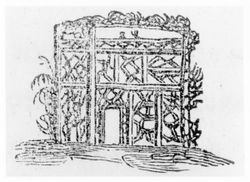
- Downing, Andrew Jackson, 1849, describing André Parmentier’s Horticultural and Botanical Garden, Brooklyn, NY (1849; repr., 1991: 459–60)[32]
- “Those of our readers who may have visited the delightful garden and grounds of M. Parmentier. . . will readily remember the rustic prospect-arbor, or tower, Fig. 87, which was situated at the extremity of his place. It was one of the first pieces of rustic work of any size, and displaying any ingenuity, that we remember to have seen here; and from its summit, though the garden walks afforded no prospect, a beautiful reach of the neighborhood for many miles was enjoyed.” [Fig. 9]
- Horticola [pseud.], March 1852, “Notes on Gardens and Country Seats Near Boston,” describing Oakley Place, seat of William Pratt, Boston, MA (Horticulturist 7: 127)[33]
- “From one point in the garden a splendid birds-eye view of the surrounding country is obtained, studded with villages, school houses and church spires—constituting the finest prospect we have seen in the vicinage of Boston.”
Citations
- Parkinson, John, 1629, Paradisi in Sole Paradisus Terrestris (1629; repr., 1975: 1)[34]
- “. . . having the fairest buildings of the house facing the garden in this manner before specified, besides the benefit of shelter it shall have from them, the buildings and roomes abutting thereon, shall have reciprocally the beautifull prospect into it, and have both sight and sent of whatsoever is excellent, and worthy to give content out from it, which is one of the greatest pleasures a garden can yeeld his Master.”
- Mortimer, J., 1708, “The Whole Art of Husbandry” (quoted in Hammond 1982: 33)[35]
- “If on thy native Soil thou dost prepare
- T’erect a Villa, thou must place it there
- Where a free Prospect does itself lend
- Into a Garden, where the sun may lend
- His influence from the East; his radiant heat
- Should on your House thro’ various Windows
- beat. . .
- “[A garden should have one central walk] which is to lead from one of the principal or more frequented rooms in your house, and if possible you should cause it to terminate in the best prospect your situation will afford.”
- Switzer, Stephen, 1718, Ichnographia Rustica (1718: 2:200)[36]
- “If the Wood is thin, ’tis there one may clear it quite away, and make open Lawns. And if the Wood be an Eminence, then all the small Stuff on the Outside ought to be clear’d away, to open the distant Prospect, if it deserve it; but if it be an unsightly, barren Prospect, then let the Wood remain to blind it.”

- Gibbs, James, 1728, A Book of Architecture (1728: xix)[37]
- “A circular Building in the form of a Temple, 20 feet in Diameter, having a Peristylium round it of the Dorick Order, and adorn’d with a Cupola; erected in his Grace the Duke of Bolton’s Garden at Hackwood, upon the upper ground of an Amphitheatre, back’d with high Trees that render the Prospect of the Building very agreeable.” [Fig. 10]
- Chambers, Ephraim, 1743, Cyclopaedia (1743: 2:n.p.)[38]
- “[vol. 1] AVENUE. . .
- “All avenues, Mortimer says, should lead to the front of an house, garden-gate, highway-gate, or wood, and terminate in a prospect.—In an avenue to an house, whatever the length of the walk is, it ought to be as wide as the whole breadth of the front; and if wider, better. . .
- “[vol. 2] TERRACE, or TERRAS, a walk, or bank of earth raised in a garden or court, to a due elevation for a prospect. See WALKS.”
- Johnson, Samuel, 1755, A Dictionary of the English Language (1755: 2:n.p.)[39]
- “PRO’SPECT. n.s. [prospectus, Lat.]
- “1. View of something distant. . .
- “2. Place which affords an extended view. . .
- “3. Series of objects open to the eye. . .
- “4. Object of view.”
- Ware, Isaac, 1756, A Complete Body of Architecture (1756: 639–40)[40]
- “THE buildings admitted into gardens may be arranged under two general heads; those which are erected as objects in themselves, and those from which prospects and other objects are to be viewed. . . Where the sole intent is to admit a prospect, and give repose after walking, the form [of the building] may be plain and simple, convenient and unornamented. Where it serves at once as a place of repose, and as a point from which to view a prospect; the convenience and the elegance of its form are both to be consulted; and finally, when it serves as an object in some rich part of an extensive garden, it must be larger and more elevated, as well as more decorated.”
- Mawe, Thomas, and John Abercrombie, 1778, The Universal Gardener and Botanist (1778: n.p.)[41]
- “As to the place of disposition of this garden [ kitchen garden ]. . . it should generally be placed detached entirely from the pleasure-ground; also as much out of view of the habitation as possible, at some reasonable distance, either behind it, or towards either side thereof, so as its walls or other fences may not obstruct any desirable prospect either of the pleasure-garden, park, fields, or the adjacent country.”
- Anonymous, 1798, Encyclopaedia (1798: 7:542)[42]
- “For the convenience of walking in damp weather, this lawn should be surrounded with a gravel-walk, on the outside of which should be borders three or four feet wide for flowers: and from the back of these the prospect will be agreeably terminated by a slope of ever-green shrubs; which, however, should never be suffered to exclude agreeable prospects, or the view of handsome buildings. These walks may lead through the different plantations, gently winding about in an easy natural manner; which will be more agreeable than either those long straight walks, too frequently seen in gardens, or those serpentine windings that are twisted about into so many short turns as to render it difficult to walk in them; and as no garden can be pleasing where there is a want of shade and shelter, these walks should lead as soon as possible into plantations, where persons may walk in private, and be sheltered from the wind.”
- M’Mahon, Bernard, 1806, The American Gardener’s Calendar (1806: 56–59)[43]
- “Therefore, in laying out pleasure-ground, the designer ought to take particular care, that the whole extent be not taken in at one view; only exhibiting at first a large open lawn, or other spacious open compartment, or grand walk, &c. terminated on each side with plantations of curious trees, shrubs and flowers, exhibiting only some opens at intervals. . . so that a spectator will be agreeably surprised to find, that what terminated his prospect, only served as an introduction new beauties and varieties. . .
- “This ground must be more contracted as it approaches, near the mansion, that company may the sooner arrive in the walks of the shrubbery, wilderness, &c. under the shade and shelter of trees; but the outward extension on each boundary, should widen gradually towards the extreme termination, to give an air of grandeur, and admit of a full prospect from and to the mansion. . .
- “In other parts are sometimes discovered eminences, or rising grounds, as a high terrace, mount, steep declivity, or other eminence, ornamented with curious trees and shrubs, with walks leading under the shade of trees, by easy ascents to the summit, where is presented to the view, an extensive prospect of the adjacent fields, buildings, hamlets, and country around, and likewise affording a fresh and cooling air in summer.”
- Parmentier, André, 1828, The New American Gardener (quoted in Fessenden 1828: 185–86)[44]
- “Limited prospects, and neighbouring houses and buildings not worthy of notice, should be concealed, and the view left open to those objects which strike the eye of the beholder agreeably. . .
- “If the house is placed on an eminence or side-hill, the prospect will be much more beautiful if you can enjoy the view of water.”
- Webster, Noah, 1828, An American Dictionary of the English Language (1828: 2:n.p.)[45]
- “PROS’PECT, n. [L. prospectus, prospicio, to look forward; pro and specio, to see.]
- “1. View of things within the reach of the eye.
- “Eden and all the coast in prospect lay. Milton.
- “2. View of things to come; intellectual sight; expectation. . .
- “3. That which is presented to the eye; the place and the objects seen. There is a noble prospect from the dome of the state house in Boston, a prospect diversified with land and water, and every thing that can please the eye.
- “4. Object of view.
- “Man to himself
- “Is a large prospect. Denham.
- “5. View delineated or painted; picturesque representation of a landscape. Reynolds.
- “6. Place which affords an extended view. Milton.
- “7. Position of the front of a building; as a prospect towards the south or north. Ezek. xl.”
- Teschemacher, James E., November 1, 1835, “On Horticultural Architecture” (Horticultural Register 1: 409–12)[46]
- “Where larger spaces of ground are to be operated on ornamentally, the first point is to open before the principal front of the house, an extensive plot of well kept grass interrupted with clumps of forest trees at considerable distances from each other, so managed as to admit between the intervals, the most interesting points of the surrounding prospect, such as the spire of a meetinghouse, a distant mountain, or a piece of water, the boundaries or which might be purposely hidden by these clumps so that if the extent of water be small the terminations would not appear. . .
- “In forming ascents to rising grounds, where prospects are to be enjoyed, there is some art required to make the attainment of the elevation easy; this is done by cutting low steps at considerable intervals, say ten or twenty feet, according to the nature of the ground. . . Such paths to eminences are preferable when they wind round and gradually reach the summit.”
- Downing, Andrew Jackson, August 1836, “Remarks on the Fitness of the Different Styles of Architecture for the Construction of Country Residences, and on the Employment of Vases in Garden Scenery” (American Gardeners’ Magazine 2: 283)[47]
- “There can scarcely be a more appropriate, agreeable and beautiful residence for a citizen who retires to the country for the summer, than a modern Italian villa, with its ornamented chimneys, its broad verandah, forming a fine shady promenade, and its cool breezy apartments. Placed where a pleasant prospect could be enjoyed—a few statues distributed with taste over the well-kept lawn—a few Italian poplars, with their conical summits rising out of the gracefully-rounded clumps of foliage which should surround it—the whole would be quite perfect and delightful.”
- Anonymous, April 1, 1837, “Landscape Gardening” (Horticultural Register 3: 127–28, 130)[48]
- “In forming plantations of trees and shrubs, so as to produce a pleasing landscape effect, few rules can be given which would apply generally. . .
- “In grounds of any considerable extent, the view of the whole should never be taken in at once; but it should be so divided into different scenes or compartments, which may be bounded by trees, that only a small part is visible at first to the spectator; but as he advances, new and varied prospects open upon him, so that he is agreeably surprised to find, that what at first seemed to terminate his view, only served to introduce him to new beauties.”

- Downing, Andrew Jackson, 1849, A Treatise on the Theory and Practice of Landscape Gardening (1849; repr., 1991: 459–60)[49]
- “A prospect tower is a most desirable and pleasant structure in certain residences. Where the view is comparatively limited from the grounds, on account of their surface being level, or nearly so, it often happens that the spectator, by being raised some twenty-five or thirty feet above the surface, finds himself in a totally different position, whence a charming coup d’oeil or bird’s-eye view of the surrounding country is obtained. . .
- “Figure 88 is a design for a rustic prospect tower of three stories in height, with a double thatched roof. It is formed of rustic pillars or columns, which are well fixed in the ground, and which are filled in with a fanciful lattice of rustic branches. A spiral staircase winds round the interior of the platform of the second and upper stories, where there are seats under the open thatched roof.” [Fig. 11]
Images
Inscribed
James Gibbs, “A Circular Building in the Form of a Temple,” in A Book of Architecture (1728), pl. 72.
Anonymous, The South West Prospect of the Seat of Colonel George Boyd of Portsmouth, New Hampshire, New England, 1774.
Anonymous, “Design for a rustic prospect tower,” in A. J. Downing, A Treatise on the Theory and Practice of Landscape Gardening, 4th ed. (1849), 460, fig. 88.
Matthew Vassar, Plan of Springside, 1851. "Prospect Hill (33). . . rises high above the others, and affords extensive view. . ."
Associated
Benjamin Henry Latrobe, View to the North from the Lawn at Mount Vernon, 1796.
George Beck, View of Baltimore from Howard Park, c. 1796.
Alexander Robertson (artist), Francis Jukes (engraver), “Mount Vernon in Virginia,” 1800.
George Ropes, Mount Vernon, 1806.
William Russell Birch, “Montibello the seat of Genl. S. Smith Maryland,” in The Country Seats of the United States (1808), pl. 13.
William Strickland, “The Woodlands,” 1809, in Casket 5, no. 10 (October 1830): pl. opp. 432.
Anonymous, “View in the Meadow Park at Geneseo,” in A. J. Downing, ed., Horticulturist 3, no. 4 (October 1848): pl. opp. 153.
Alexander Jackson Davis, “View in the Grounds at Blithewood,” in A. J. Downing, A Treatise on the Theory and Practice of Landscape Gardening, 4th ed. (1849), frontispiece.
Anonymous, “View in the Grounds at Hyde Park,” in A. J. Downing, A Treatise on the Theory and Practice of Landscape Gardening, 4th ed. (1849), pl. opp. 45, fig. 1.
Alexander Jackson Davis, “Bank-Side Walk,” Blithewood, 1849.
Alexander Jackson Davis, Three figures going up a hill to a gazebo at Blithewood, n.d. [c. 1849].
William Matthew Prior, Washington’s Tomb at Mount Vernon, c. 1855.
Anonymous, “Rustic prospect-arbor,” in A. J. Downing, A Treatise on the Theory and Practice of Landscape Gardening, 4th ed. (1849), 460, fig. 87.
Attributed
Jonathan Budington, View of the Cannon House and Wharf, 1792.
Benjamin Henry Latrobe, View of Mount Vernon looking to the North, July 17, 1796.
Benjamin Henry Latrobe, View of Mount Vernon looking towards the South West, 1796.
John Archibald Woodside, Lemon Hill, 1807.
Janika de Fériet, The Hermitage, c. 1820.
Notes
- ↑ For a discussion of the relation of control of resources and the creation of prospects in the garden, see Denis E. Cosgrove, Social Formation and Symbolic Landscape (New York: Oxford University Press, 1984), view on Zotero, particularly chapters 6 and 7; Raymond Williams, The Country and the City (1973; repr., London: Hogarth Press, 1985), view on Zotero; Elizabeth Kryder-Reid, “The Archaeology of Vision in Eighteenth-Century Chesapeake Gardens,” Journal of Garden History 14 (Spring 1994): 42–54, view on Zotero; and Dianne Suzette Harris and D. Fairchild Ruggles, eds., Sites Unseen: Landscape and Vision (Pittsburgh: University of Pittsburgh Press, 2007), view on Zotero. For a discussion of the links among optics, monumental architecture (including landscapes), and social control, see Jerry D. Moore, Architecture and Power in the Ancient Andes (Cambridge: Cambridge University Press, 1996), 98–101, 168–73, view on Zotero.
- ↑ Charles Thomforde, “William Penn’s Estate at Pennsbury and the Plants of Its Kitchen Garden” (MS thesis, University of Delaware, 1986), view on Zotero.
- ↑ William Byrd, A Journey to the Land of Eden and Other Papers (New York: Macy-Masius, 1928), view on Zotero.
- ↑ U. P. Hedrick, A History of Horticulture in America to 1860; with an Addendum of Books Published from 1861–1920 (Portland, OR: Timber Press, 1988), view on Zotero.
- ↑ Eliza Lucas Pinckney, The Letterbook of Eliza Lucas Pinckney, 1739–1762, ed. Elise Pinckney (Chapel Hill: University of North Carolina Press, 1972), view on Zotero.
- ↑ Hannah Callender Sansom, The Diary of Hannah Callender Sansom: Sense and Sensibility in the Age of the American Revolution, ed. Susan E. Klepp and Karin Wulf (Ithaca: Cornell University Press, 2010), view on Zotero.
- ↑ Josiah Quincy, “Journal of Josiah Quincy,” Massachusetts Historical Society, Proceedings 49 (1916), view on Zotero.
- ↑ Barbara Wells Sarudy, “Eighteenth-Century Gardens of the Chesapeake,” Journal of Garden History 9 (1989): 104–59, view on Zotero.
- ↑ Fred Shelley, ed., “The Journal of Ebenezer Hazard in Virginia, 1777,” Virginia Magazine of History and Biography 62 (1954): 400–23, view on Zotero.
- ↑ 10.0 10.1 Elizabeth Cometti, ed., The American Journals of Lt. John Enys (Syracuse, NY: Adirondack Museum and Syracuse University Press, 1976), view on Zotero.
- ↑ Thomas Anburey, Travels through the Interior Parts of America, 2 vols. (New York: New York Times and Arno Press, 1969), view on Zotero.
- ↑ Thomas Lee Shippen, Westover Described in 1783: A Letter and Drawing Sent by Thomas Lee Shippen, Student of Law in Williamsburg, to His Parents in Philadelphia (Richmond, VA: William Byrd Press, 1952), view on Zotero.
- ↑ William Parker Cutler, Life, Journals, and Correspondence of Rev. Manasseh Cutler, LL.D. (Athens: Ohio University Press, 1987), view on Zotero.
- ↑ 14.0 14.1 J.-P. (Jacques-Pierre) Brissot de Warville, New Travels in the United States of America, Performed in 1788, ed. Durand Echeverria, trans. Maro S. Vamos and Durand Echeverria (Cambridge, MA: Belknap, 1964), view on Zotero.
- ↑ Karen Madsen, “William Hamilton’s Woodlands,” (paper presented for seminar in American Landscape, 1790–1900, instructed by E. McPeck, Radcliffe Institute for Advanced Study, Harvard University, 1988), view on Zotero.
- ↑ Constantia [Judith Sargent Murray], “Description of Gray’s Gardens, Pennsylvania,” Massachusetts Magazine, or, Monthly Museum of Knowledge and Rational Entertainment 7, no. 3 (July 1791): 413–17, view on Zotero.
- ↑ William Bentley, The Diary of William Bentley, D.D., Pastor of the East Church, Salem, Massachusetts (Gloucester, MA: Peter Smith, 1962), view on Zotero.
- ↑ William Loughton Smith, Journal of William Loughton Smith, 1790–1791, ed. Albert Matthews (Cambridge, MA: The University Press, 1917), view on Zotero.
- ↑ H. Paul Caemmerer, The Life of Pierre-Charles L’Enfant, Planner of the City Beautiful, The City of Washington (Washington, DC: National Republic Publishing Company, 1950), view on Zotero.
- ↑ François-Alexandre-Frédéric duc de La Rochefoucauld Liancourt, Travels through the United States of North America, the Country of the Iroquois, and Upper Canada, in the Years 1795, 1796, and 1797, ed. Brisson Dupont and Charles Ponges, trans. H. Newman, 2nd ed., 4 vols. (London: R. Philips, 1800), view on Zotero.
- ↑ Thomas Twining, Travels in America 100 Years Ago: Being Notes and Reminiscences (New York: Harper, 1894), view on Zotero.
- ↑ Timothy Dwight, Travels in New England and New York, 4 vols. (New Haven, CT: Timothy Dwight, 1821), view on Zotero.
- ↑ Isaac Weld, Travels through the States of North America and the Provinces of Upper and Lower Canada, during the Years 1795, 1796, and 1797 (London: John Stockdale, 1799), view on Zotero.
- ↑ Sir Augustus John Foster, Jeffersonian America: Notes on the United States of America Collected in the Years 1805–1806–1807 and 1811–1812, ed. Richard Beale Davis (San Marino, CA: Huntington Library, 1954), view on Zotero.
- ↑ Samuel Ripley, “A Topographical and Historical Description of Waltham, in the County of Middlesex, Jan. 1, 1815,” Collections of the Massachusetts Historical Society 3 (January 1815): 261–84, view on Zotero.
- ↑ John Lambert, Travels through Canada, and the United States of North America in the Years 1806, 1807, and 1808, 2 vols. (London: Baldwin, Cradock, and Joy, 1816), view on Zotero.
- ↑ Anonymous, “Rural Taste,” New England Farmer 6, no. 50 (July 4, 1828): 397, view on Zotero.
- ↑ James Thacher, “An Excursion on the Hudson. Letter II,” New England Farmer, and Horticultural Journal 9, no. 20 (December 3, 1830): 156–57, view on Zotero.
- ↑ Frances Anne Kemble, Journal of a Residence on a Georgian Plantation in 1838–1839, ed. John A. Scott (Athens: University of Georgia Press, 1984), view on Zotero.
- ↑ B. P., “Progress of Horticulture in Rochester, N.Y.,” Magazine of Horticulture, Botany, and All Useful Discoveries and Improvements in Rural Affairs 10, no. 1 (January 1844): 15–19, view on Zotero.
- ↑ A. J. Downing, “The Meadow Park of Geneseo,” Horticulturist and Journal of Rural Art and Rural Taste 3, no. 4 (October 1848): 163–66, view on Zotero.
- ↑ A. J. [Andrew Jackson] Downing, A Treatise on the Theory and Practice of Landscape Gardening, Adapted to North America, 4th ed. (1849; Washington, DC: Dumbarton Oaks Research Library and Collection, 1991), view on Zotero.
- ↑ Horticola [pseud.], “Notes on Gardens and Country Seats near Boston,” The Horticulturist and Journal of Rural Art and Rural Taste 7, no. 3 (March 1852): 126–28, view on Zotero.
- ↑ John Parkinson, Paradisi in Sole Paradisus Terrestris (1629; Norwood, NJ: W. J. Johnson, 1975), view on Zotero.
- ↑ Charles Arthur Hammond, “‘Where the Arts and the Virtues Unite’: Country Life Near Boston, 1637–1864” (PhD diss., Boston University, 1982), view on Zotero.
- ↑ Stephen Switzer, Ichnographia Rustica, or The Nobleman, Gentleman and Gardener’s Recreation. . ., 3 vols. (London: D. Browne, 1718), view on Zotero.
- ↑ James Gibbs, A Book of Architecture, Containing Designs of Buildings and Ornaments (London: Printed for W. Innys et al., 1728), view on Zotero.
- ↑ Ephraim Chambers, Cyclopaedia, or An Universal Dictionary of Arts and Sciences. . . , 5th ed., 2 vols. (London: D. Midwinter et al., 1741–43), view on Zotero.
- ↑ Samuel Johnson, A Dictionary of the English Language: In Which the Words Are Deduced from the Originals and Illustrated in the Different Significations by Examples from the Best Writers, 2 vols. (London: W. Strahan for J. and P. Knapton, 1755), view on Zotero.
- ↑ Isaac Ware, A Complete Body of Architecture (London: T. Osborne and J. Shipton, 1756), view on Zotero.
- ↑ Thomas Mawe and John Abercrombie, The Universal Gardener and Botanist, or A General Dictionary of Gardening and Botany (London: Printed for G. Robinson et al., 1778), view on Zotero.
- ↑ Anonymous, Encyclopaedia, or A Dictionary of Arts, Sciences, and Miscellaneous Literature, 18 vols. (Philadelphia: Thomas Dobson, 1798), view on Zotero.
- ↑ Bernard M’Mahon, The American Gardener’s Calendar: Adapted to the Climates and Seasons of the United States. Containing a Complete Account of All the Work Necessary to Be Done. . . for Every Month of the Year. . . (Philadelphia: Printed by B. Graves for the author, 1806), view on Zotero.
- ↑ Thomas Fessenden, The New American Gardener (Boston: J. B. Russell, 1828), view on Zotero.
- ↑ Noah Webster, An American Dictionary of the English Language, 2 vols. (New York: S. Converse, 1828), view on Zotero.
- ↑ James E. Teschemacher, “On Horticultural Architecture,” Horticultural Register, and Gardener’s Magazine 1 (November 1, 1835): 409–12, view on Zotero.
- ↑ A. J. Downing, “Remarks on the Fitness of the different Styles of Architecture for the Construction of Country Residences, and on the Employment of Vases in Garden Scenery,” American Gardeners’ Magazine, and Register of Useful Discoveries and Improvements in Horticulture and Rural Affairs 2, no. 8 (August 1836): 281–86, view on Zotero.
- ↑ Anonymous, “Landscape Gardening,” Horticultural Register, and Gardener’s Magazine 3 (April 1, 1837): 121–31, view on Zotero.
- ↑ A. J. [Andrew Jackson] Downing, A Treatise on the Theory and Practice of Landscape Gardening, Adapted to North America, 4th ed. (1849; Washington, DC: Dumbarton Oaks Research Library and Collection, 1991), view on Zotero.
